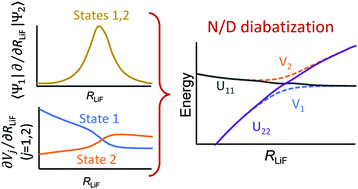Direct diabatization based on nonadiabatic couplings: the N/D method†
Abstract
Diabatization converts adiabatic electronic states to diabatic states, which can be fit with smooth functions, thereby decreasing the computational time for simulations. Here we present a new diabatization scheme based on components of the nonadiabatic couplings and the adiabatic energy gradients. The nonadiabatic couplings are multi-dimensional vectors that are singular along conical intersection seams, and this makes them essentially impossible to fit; furthermore they have unphysical aspects due to the assumptions of the generalized Born–Oppenheimer scheme, and therefore they are not usually used in diabatization schemes. However, we show here that the nonadiabatic couplings can provide a route to obtaining diabatic states by using the sign change of the energy gradient differences of adiabatic states on paths through conical intersections or locally avoided crossings. We present examples applying the method successfully to several test systems. We compare the method to other diabatization methods previously developed in our group.



 Please wait while we load your content...
Please wait while we load your content...
